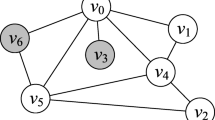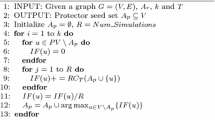Abstract
The spread of rumors in online networks threatens public safety and results in economic losses. To overcome this problem, a lot of work studies the problem of rumor control which aims at limiting the spread of rumors. However, all previous work ignores the relationship between the influence block effect and counts of impressions on the user. In this paper, we study the problem of minimizing the spread of rumors when impression counts. Given a graph G(V, E), a rumor set \(R \in V\), and a budget k, it aims to find a protector set \(P \in V \backslash R\) to minimize the spread of the rumor set R under the budget k. Due to the impression counts, two following challenges of our problem need to be overcome: (1) our problem is NP-hard; (2) the influence block is non-submodular, which means a straightforward greedy approach is not applicable. Hence, we devise a branch-and-bound framework for this problem with a (\(1-1/e-\epsilon \)) approximation ratio. To further improve the efficiency, we speed up our framework with a progressive upper bound estimation method, which achieves a (\(1-1/e-\epsilon - \rho \)) approximation ratio. We conduct experiments on real-world datasets to verify the efficiency, effectiveness, and scalability of our methods.
Access this chapter
Tax calculation will be finalised at checkout
Purchases are for personal use only
Similar content being viewed by others
Notes
References
Albert, R., Jeong, H., Barabási, A.L.: Error and attack tolerance of complex networks. Nature 406(6794), 378 (2000)
Bharathi, S., Kempe, D., Salek, M.: Competitive influence maximization in social networks. In: WINE, pp. 306–311 (2007)
Borodin, A., Filmus, Y., Oren, J.: Threshold models for competitive influence in social networks. In: WINE, pp. 539–550 (2010)
Budak, C., Agrawal, D., El Abbadi, A.: Limiting the spread of misinformation in social networks. In: WWW, pp. 665–674 (2011)
Carnes, T., Nagarajan, C., Wild, S.M., van Zuylen, A.: Maximizing influence in a competitive social network: a follower’s perspective. In: ACMicec, pp. 351–360 (2007)
Feder, G., Just, R.E., Zilberman, D.: Adoption of agricultural innovations in developing countries: a survey. EDCC 33(2), 255–298 (1985)
Habiba, Yu, Y., Berger-Wolf, T.Y., Saia, J.: Finding spread blockers in dynamic networks. In: SNAKDD, pp. 55–76 (2008)
Lancaster, T.: The Econometric Analysis of Transition Data, No. 17. Cambridge University Press, Cambridge (1990)
Mo, S., Bao, Z., Zhang, P., Peng, Z.: Towards an efficient weighted random walk domination. PVLDB 14(4), 560–572 (2020)
Mo, S., Tian, S., Wang, L., Peng, Z.: Minimizing the spread of rumor within budget constraint in online network. In: Sun, X., He, K., Chen, X. (eds.) NCTCS 2019. CCIS, vol. 1069, pp. 131–149. Springer, Singapore (2019). https://doi.org/10.1007/978-981-15-0105-0_9
Newman, M.E., Forrest, S., Balthrop, J.: Email networks and the spread of computer viruses. Phys. Rev. E 66(3), 035101 (2002)
Palda, K.S.: The measurement of cumulative advertising effects. J. Bus. 38(2), 162–179 (1965)
Spitzer, F.: Principles of Random Walk, vol. 34. Springer, New York (2013). https://doi.org/10.1007/978-1-4757-4229-9
Taylor, J., Kennedy, R., Sharp, B.: Is once really enough? Making generalizations about advertising’s convex sales response function. J. Advert. Res. 49(2), 198 (2009)
Xu, P., Peng, Z., Wang, L.: Proactive rumor control: When impression counts (full version). CoRR abs/2303.10068 (2023)
Zhang, P., et al.: Proactive rumor control in online networks. WWW 22(4), 1799–1818 (2019)
Zhang, Y., Li, Y., Bao, Z., Mo, S., Zhang, P.: Optimizing impression counts for outdoor advertising. In: SIGKDD, pp. 1205–1215. ACM (2019)
Zhao, Y., Hu, Y., Yuan, P., Jin, H.: Maximizing influence over streaming graphs with query sequence. Data Sci. Eng. 6(3), 339–357 (2021)
Acknowledgements
This work is supported by the Key Project of the National Natural Science Foundation of China (Project Number: U1811263).
Author information
Authors and Affiliations
Corresponding author
Editor information
Editors and Affiliations
1 Electronic supplementary material
Below is the link to the electronic supplementary material.
Rights and permissions
Copyright information
© 2023 The Author(s), under exclusive license to Springer Nature Switzerland AG
About this paper
Cite this paper
Xu, P., Peng, Z., Wang, L. (2023). Proactive Rumor Control: When Impression Counts. In: Kashima, H., Ide, T., Peng, WC. (eds) Advances in Knowledge Discovery and Data Mining. PAKDD 2023. Lecture Notes in Computer Science(), vol 13938. Springer, Cham. https://doi.org/10.1007/978-3-031-33383-5_3
Download citation
DOI: https://doi.org/10.1007/978-3-031-33383-5_3
Published:
Publisher Name: Springer, Cham
Print ISBN: 978-3-031-33382-8
Online ISBN: 978-3-031-33383-5
eBook Packages: Computer ScienceComputer Science (R0)




